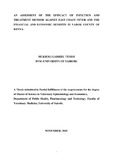| dc.description.abstract | A 5-month longitudinal controlled trial was carried out in two sub-counties of Narok County, Kenya to assess safety and efficacy of the Infection and Treatment Method (ITM) of East Coast fever immunization, using the Muguga cocktail stabilate, and to quantify the financial and economic viability of ITM.
Four herds were purposively selected, based on accessibility and willingness of the farmers, in three contrasting study sites. In each herd there were both experimental calves and control calves that were randomly selected. One-hundred-twenty-three calves were vaccinated and another one-hundred-nineteen calves were followed as controls. The two groups were followed for a period of 5 months from August, 2004 to December, 2004. There were no reactors. The antibodies to Theileria parva were 46.2% on day 0 and peaked up to 93.3% on day 35 following immunization with Muguga cocktail stabilate. The difference in antibody titres in the two periods was significant (p= 0.000). In the control herd the sero-prevalence changed from 46.5% down to 41%. The difference in antibody titres in the two periods was not significant (p=0.442107). The morbidity rate of clinical ECF was 15.1% in the control group and 1.6% in the immunized group. The difference in the two incidence rates was statistically significant (p=0.000101). The cause specific mortality of ECF was 87.5%. The vaccine efficacy was 89%. The conclusion of the study was that Muguga cocktail stabilate was safe and efficacious.
Partial budgeting analysis recorded positive net returns an indication of profitability of the ITM technology. The ITM realized a net return of Ksh.1, 559.59 per immunized calf. This was significant in the study area since the average price of a calf was relatively low (Ksh.4, 700.00). High net returns are indicators of high profitability of immunization. Thus, it can be concluded from the study that it is economically worthwhile to immunize calves against ECF in the Narok County. If immunization against the disease is integrated with reduced acaricide usage, then accrued returns are even much higher | en_US |

